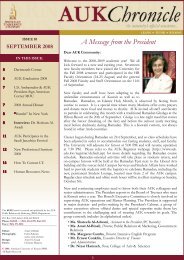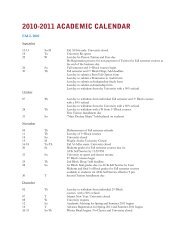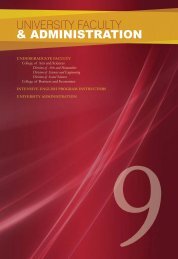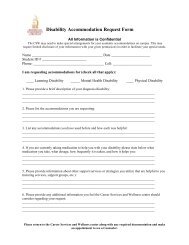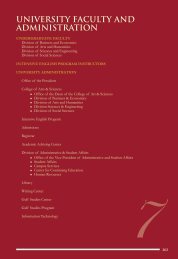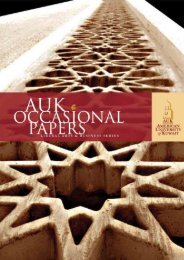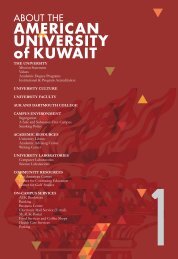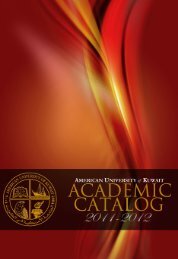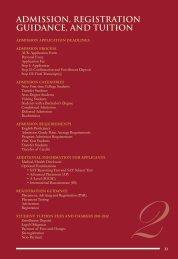Hadi and Llabre (1998) assessed intelligence, posttraumaticstress and depression among Kuwaitis one year afteroccupation. They found a difference in levels of parentaldepression between those who stayed in Kuwait ascompared to those who were out for all or part of theoccupation. Though Hadi and Llabre (1998) found lowlevels of depression in children, they found depressioncorrelated with levels of exposure to violence and levelsof PTSD. Children who had a martyr or POW in thefamily (Abdullatif 1995) and boys (Llabre and Hadi 1997)reported higher levels of depression, with social supporta protective buffer for girls.Abdel-Khalek (1997), in a survey of fears associated withIraqi aggression among Kuwaiti children and adolescents,ages 13-17 years, identified three significant factors thathe named Iraqi Aggressor, War Machinery, and WarCorrelates and Effects. Abdel-Khalek concluded that theIraqi aggression’s adverse effects persisted 5.7 years afterthe trauma. In 2004, Abdel-Khalek (2004) reported higherscores for Kuwaitis on the Arabic Scale of Death Anxiety(ASDA) than their Egyptian or Syrian counterparts.These psychological studies describe important experiencesand concerns of suffers and survivors, and criticalgenerational and gender dynamics of trauma in theaftermath of the 1990 Iraqi invasion and occupation. Thestudies, taken together, point to the ongoing traumaticeffects of the invasion and occupation. Yet, as one strandof human experience, studies based on the diagnosisof PTSD or depression alone mask the reshaping ofexperience through diverse memory processes that impactsocial relations, Kuwaiti communal recovery, and a social,historical analysis that might lead to collective politicalresponses. The question here is whether medicalizingand individualizing collective trauma supports communalrecovery, a question that has important moral, politicaland legal ramifications.Memory, PTSD and Child WitnessesContrary to popular ideas about memory, memory doesnot operate like a video camera, providing a continuousphotographic copy of events and experiences (Schacter2003). Instead, multiple learning and memory systems“extract details, meanings, and associations from thestream of experience according to specific needs,selective attention, and cognitive and perceptual salienceor relevance” (Kirmayer, Lemelson and Barad 2007:8).Memories also change, undergoing repeated revisionand transformation with each attempt at recollection. Weliterally narrate ourselves, reshaping an awareness of ourfeelings and sense of identification with others througheveryday life (Capps and Ochs 1995). This underminesclaims that symptoms, such as flashbacks, are simplyreplays of indelible records, rather than reconstructionsin complex memory processes. Symptoms, such asflashbacks, may reflect veridical recall, obsessional worry,vivid imagination or ruminations of “worst case scenarios”(Frankel 1994; Kirmayer, Lemelson and Barad 2007:8).The diversity of these memory processes leads toambiguity and debate about what is veridical recalland what is reconstructed, confabulated or fabricatedmemory, particularly when the stakes of research, beyondpsychological health, incorporate moral and legal credibilityand economic claims for compensation. While studies ofPTSD and depression offer us useful foci for psychologicaltreatment and the basis for economic compensation fromperpetrators of traumas such as violence, they may alsomask complex, relational experiences and the confluenceof diverse social memory processes.Nordstrom (2004:226) suggests that “part of the wayviolence is carried into the future is through creatinghegemony of enduring violence across the length andbreadth of the commonplace world, present and future.The normal, the innocuous, and the inescapable areinfused with associations of lethal harm”. Respondentsin our study, child witnesses of the Iraqi invasion andoccupation, vividly recalled the dangers of Iraqi checkpoints on main roads, and the destruction of communitycenters, religious sites, public parks, schoolyards, andmarketplaces, places where war was brought home. Maleand female respondents recalled intimidation, control,and powerlessness at Iraqi soldier checkpoints, andsexually aggressive or inappropriate advances toward theirmothers. Male and female respondents reported fear,anxiety, visual horror and a loss of control in response tomedia portrayals of tortured and mutilated bodies.Young men, out of the home more often than theirsisters, vividly described maimed and murdered bodiesin communal areas close to their homes: A 24 year olddescribed “torture houses”, with “piles of dead bodies,a tortured man, still alive, led from the torture house toan ambulance”. He recalled children playing football withthe head of a murdered Iraqi after the liberation. A 22year old recalled “men being executed in front of my owneyes”. He said, “I felt helpless, not only because I wasa child, but my family could not control anything…no19
20one could protect me”. He said, “My older brother tooka soldier’s decapitated head and kicked it to me. I wasscared and still remember how I felt when I saw it”. A22 year old recalled “seeing a dead man hanging from alight post,” and “walking by workout facilities and cafeswith dead bodies”. A 23 year old remembered “childrenmaking poisonous drinks as a game to kill Iraqi soldiers”,to regain a sense of control, and to take revenge.During the occupation places associated with safety, suchas the home, were recast as lethal and inhumane or asrefuges for Iraqi soldiers. Some Kuwaiti neighborhoodswere unchanged in terms of family composition, while inothers, neighbors moved away or houses were destroyed.Respondents had strikingly different experiences dependingon their neighborhoods and whether or not the occupyingIraqis were Bathists, whom our child witnesses describedas “aggressive” and “violent” or non-Bathists who were“like children”. A 23 year old male described Bathistsoldiers breaking into his family’s home: “Iraqi soldiersbroke down our door. My brother spilled water on thesoldier, and he got angry; he yelled at my brother.” Livingin an area occupied by non-Bathists, a 24 year old malesaid: “Soldiers cried; they didn’t want to be there. Theywere forced. They needed food. The soldiers played withchildren, and joked.”Interestingly, all of our respondents described the occupationas a time of their best and worst memories with theirfamilies: A 23 year old female said: “It was perfect. No onehad to be there. Everyone was there because they wantedto be there. We were never so close”. Others describedincreased domestic violence, family conflicts, alcohol anddrug abuse, and increased promiscuity.In the aftermath of violence, ‘basic trust’, as Luhrmann(2000), Ewing (2000) and Robben (2000) suggest, maydefine and flame social, cultural and political identifications,critical to post-trauma healing and to the reconstructionof trust in oneself and in the familial, institutional andcultural practices that structure daily experience. Themourning and social channeling of collective trauma—theways in which people collectively remember and forgettrauma—are powerful aspects of group identification andrecovery that impact the likelihood of future violence(Taussig 1987; Volkan 1998; White 2005).The issue of identity, whether familial, ethnic, religiousor national became a central feature in remembrancesof ‘trust’ during the occupation. Kuwaitis recalled theirfamilies obtaining fake identification, using other languagesand dialects, and increased prejudice against Kuwaitis andPalestinians. Identity and the feeling of betrayal emergedthrough a majority of interviews. One respondent toldus, “They wrote Kuwait is for Palestinians” on city walls.Another asked, “Why should there be trust? We trustedPalestinians. We gave them jobs. They made money. Theywere our brothers and look how they stabbed us in theback.” A young woman of Palestinian family backgroundand Kuwaiti citizenship described increased isolationand harassment, with Palestinians fired from jobs. Fortythousand Palestinians were exiled. Respondents also feltbetrayed by Iraqis, particularly Saddam Hussein. Oneyoung woman said, “We always looked up to Saddamprotecting us from Iran and then he invades us.” Therewere accusations of relatives stealing from homes inwhich they took shelter, so that ultimately, our Kuwaitirespondents said they could trust only the members oftheir immediate families.The 2003 U.S. War on Iraq triggered intrusive images ofthe 1990 Iraqi invasion and occupation, increased anxietyand fear that Kuwait would again be invaded. Ongoingmedia coverage of the war, walking through the Museumof War (The Kuwait House Museum), and loud noises,particularly sirens, were additional triggers. A 23 year oldfemale said, “I felt paralyzing fear and stress when I heardsirens. Months later when Kuwait was no longer in danger,the government still kept testing sirens. I would wake upduring the siren testing and feel fearful and short of breath.”While the majority of our respondents had never beendiagnosed with PTSD or depression, they describedperiods of depression, isolation, emptiness, and emotionaldisconnectedness. They lacked a sense of loyalty or trust,describing instead paranoia, dependency on friends andfamily, anger and frustration, and the feeling of having nofuture in Kuwait.Embodied Memory and the Social EnvironmentThe contested idea that trauma involves “embodiedmemory” is framed differently in psychological and social,cultural research (Brewin 2003; Connerton 1989; van derKolk 1994; Stoller 1995). According to Kirmayer, Lemelsonand Barad (2007: 8-9), “The body (more specifically,circuits involving subcortical and cortical areas of the brainnot accessible to consciousness) acquires associationsas conditioned emotional responses or habits…but thisdoes not yield declarative memory, and the origins of thelearned association cannot be directly described unless
- Page 2 and 3: About AUK Occasional Papers:The AUK
- Page 4 and 5: higher education is distinguished b
- Page 6 and 7: The Impact of a Glass Ceilingon Wom
- Page 8 and 9: more women a chance to flourish in
- Page 10 and 11: consider other factors such as the
- Page 12 and 13: academically unprepared…you must
- Page 14 and 15: EmotionalSignificant variations in
- Page 16 and 17: Advising and OrientationOther impor
- Page 18 and 19: etention. However, in addition, the
- Page 22 and 23: the event was encoded in parallel a
- Page 24 and 25: Public Health Impacts of Iraq’s 1
- Page 26 and 27: college work and have inadequate pr
- Page 28 and 29: memorization and repetition. This a
- Page 30 and 31: other in the pursuit of higher grad
- Page 32 and 33: for quality assurance, an organizat
- Page 34 and 35: RethinkingEntrepreneurship:Integrat
- Page 36 and 37: This type of training leads to enha
- Page 38 and 39: In short, Mount Allison students ha
- Page 40 and 41: Joplin, L. (1995). On defining expe
- Page 42 and 43: Figure 1. ExperientialEntrepreneurs
- Page 44 and 45: Kuwait - satellite television, cult
- Page 46 and 47: ReferencesAbt, V. & Seesholtz, M. (
- Page 48 and 49: interest in continuing to manipulat
- Page 50 and 51: Though corruption poses fundamental
- Page 52 and 53: A Cross-Cultural Modelof Innovation
- Page 54 and 55: were conceived as associations of c
- Page 56: others. In this case, confident pos
- Page 59 and 60: 58REFERENCESAmason, A. (1996) ‘Di
- Page 61 and 62: Shelton, C. and Darling, J. (2004)
- Page 63 and 64: 62• recycle natural resources use
- Page 65 and 66: 64Table Kuwait Fact Profile on Tran
- Page 67 and 68: Table Transportation and Associated
- Page 69 and 70: 68• Third, each mode of transport
- Page 71 and 72:
70• Prepare a Bank Group transpor
- Page 73 and 74:
7219. Stratford,A. (1974). Airports
- Page 75 and 76:
74may be developed in a safe and or
- Page 77 and 78:
28. Tables - 1 Environmental Manage
- Page 79 and 80:
6) EnvironmentalAwarenessNo baselin
- Page 81 and 82:
80Iran, the US, and HighlyEnriched
- Page 83 and 84:
82since the 1951 nationalization of
- Page 85 and 86:
8450% of the population is astonish
- Page 87 and 88:
86The US also approved the Shah’s
- Page 89 and 90:
88George W. Bush’s State of the U
- Page 91 and 92:
90when Iran could not keep up with
- Page 93 and 94:
92rich states, the decrease of natu
- Page 95 and 96:
94indigenous training. Specifically
- Page 97 and 98:
96It is important to note that Russ
- Page 99 and 100:
Table 1: Nuclear Powered States and
- Page 101 and 102:
100Foucault, Michel. “What are th
- Page 103 and 104:
102Ramazani, Rouhollah K. “Iran
- Page 105 and 106:
104My SCORE, OurMATCH: CommunityPar
- Page 107 and 108:
106with a mate while he does mechan
- Page 109 and 110:
108dimensions of life including for
- Page 111 and 112:
correlated to the commitment and on
- Page 113 and 114:
REFERENCESBryce, J, Frigo, T, McKen
- Page 115 and 116:
GDP $21,300, GDP growth rate 6.8%,
- Page 117 and 118:
• Less than half of the people su
- Page 119 and 120:
118TABLE 4: # 1 Gulf Country in Eco
- Page 121 and 122:
120• More men than women indicate
- Page 123 and 124:
TABLE 8: Why? X GenderGENDERMALE FE
- Page 125 and 126:
TABLE 11: Success in improving Livi
- Page 127 and 128:
TABLE 14: Success in preserving Cul
- Page 129 and 130:
• Gender wise, more men felt that
- Page 131 and 132:
TABLE 18: How foreign workers are t
- Page 133 and 134:
• In terms of the preference of e
- Page 135 and 136:
TABLE 24: Should Oil be the Basis f
- Page 137 and 138:
F i gur e 18: S hould K uwa it J oi
- Page 139 and 140:
13811. What do you think about the
- Page 141 and 142:
140Conditions of Kuwaiti Dependence
- Page 143 and 144:
1422) if the alien has no means of
- Page 145 and 146:
144offered Mubarak recognition as a
- Page 147 and 148:
146labor regulations and enforcemen
- Page 149 and 150:
148intensifying suspicion and hosti
- Page 151 and 152:
150Commission on Freedom of the Pre
- Page 153 and 154:
Even the viceroy of India, Lord Cur
- Page 155:
Christine PiconeAustralian College



